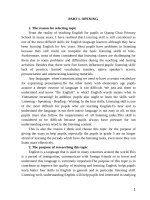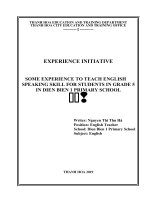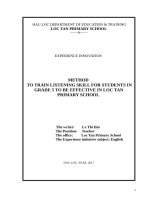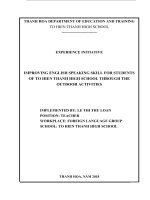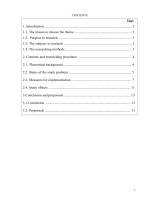Method to train english listening skill for students in grade 5 to be effective in loc tan primary school
Bạn đang xem bản rút gọn của tài liệu. Xem và tải ngay bản đầy đủ của tài liệu tại đây (236.73 KB, 18 trang )
HAU LOC DEPARTMENT OF EDUCATION & TRAINING
LOC TAN PRIMARY SCHOOL
--------&-------
EXPERIENCE INNOVATION
METHOD
TO TRAIN LISTENING SKILL FOR STUDENTS IN
GRADE 5 TO BE EFFECTIVE IN LOC TAN
PRIMARY SCHOOL
The writer:
Le Thi Hai
The Position: Teacher
The office:
Loc Tan Primary School
The Experience initiative subject: English
HAU LOC, YEAR 2017
1
The contents
1. INTRODUCTION.
1.1 The reason for selecting the topic
1.2. The studying purpose of this topic
1.3. The studying subjects.
1.4. The studying menthods.
2. THE CONTENT OF THIS EXPERIENCE
2.1. The theoretical basis.
2.2.The real situation of the studying issue.
2.2.1. Current status of the school.
2.2.2. About students and parents.
2.2.3. For teacher
2.3. Solution and implementation.
2.3.1. Flexible use good techniques in a more or partly taught listening
skill.
2.3.2. Combining practice listening to other technical groups.
2.3.2.1. The technical team practice facility.
2.3.2.2. Stress training technical Group.
2.3.2.3. Expand technical training group.
2.4.The effects of this initative
2.4.1. For my school
Page
1
1
1
2
2
2
2
2
2
2
3
5
5
8
8
10
11
12
12
2
2.4.2 Experiential Lessons for colleagues and me.
3. CONCLUSION AND PROPOSAL.
3.1. Conclusion.
3.2. Proposal.
13
13
13
13
INDEX
1. INTRODUCATION
1.1. The reason for selecting the topic.
Nowadays the trend of international integration in many areas including
the field of education has brought English up a very important position. English
as a means of communication is the key to the treasure of humanity. On the
other hand, the wide application of information technology has made learning
English become urgent and indispensable. So learning English of Elementary
School students is particularly concerned by students, parents, all the teachers of
education in our country. English has become one of the main subjects in the
curriculum of students.
Learning and use of English require a diligent process of creative practice
of both learners and teachers. Especially in the situation of education reform as
currently, teaching English in view of communication methods is widely
supported. According to this method, students have many opportunities to
communicate, to practise language and to participate in practical situations:
Learning coupled with practising.
1.2. The studying purpose of this topic.
Primary level English program has been implemented in all regions across
the country. Innovation prominent feature of the content of this program is to
provide maximum opportunities for students to practise four skills of listening,
speaking, reading and writing on the topics and situations, communication
content related to environment living at home and abroad . The change in
facilitating the teaching and learning of English in secondary schools becomes
teaching living language instead of teaching words as many years ago. However,
in practical English skills forged for students, teachers confronted with many
difficulties, especially listening skill forged. Through my school in the rural
areas, when students started to learn foreign languages, most of them were very
interested in English, but eventually they fell tired of it. Most of them are very
bad at listening skill. It's difficult for them to understand the content of an essay
or dialogue they hear. After each listening lesson, the teacher meets difficulty
checking information that students had heard and checking old lesson often not
easy.
Facing with that situation as a direct teachers to teach English for students
in grade 5, who were exposed to the English language through grade 3,4, I
3
myself always think of how to help students master, listen comprehension and
maturely manipulate information. During both teaching and observing the
students, I found the discipline and listening skill of the students having a lot of
problems. Most students do not know how to learn listening, ear training
students often find most difficult. In the classroom, students often say that
although there are many words in the test they know but they can not hear out.
How to help students to use vocabularies and grammatical structures itself to
effective listening? Therefore, in the teaching process, I find a number of
methods for positive, simple, easy to understand practical ensure science to
develop thinking ability, speculation and creativity of students. With my little
experience I boldly go into a problem "Method to train English listening skill for
students in grade 5 to be effective in Loc Tan primary School".
1.3. The studying subjects.
Method to train English listening skill for students in grade 5 to be
effective in Loc Tan primary School
1.4. The studying menthods.
- Read related material to the topic.
- Study content of the 5th grade English program.
- Learn from teaching experience.
- Exchange with colleagues about the methods of educating students.
- Comparision the development about the knowledge at the same age among the
students in classes.
2. THE CONTENT OF THIS EXPERIENCE
2.1. The theoretical basis.
English, one of the foreign languages, has been being learned by many
Vietnamese people for communicating, learning and research. Currently,
because of new method in learning and teaching, students have more favorable
exposure to the English language. Students have the opportunity to
communicate with people in English and easy to apply in life. Prominent feature
of the innovation agenda for new textbooks is maximum opportunity for
students to practice 4 skills. In that, listening skill is one of the focused skills
development in the new methods of teaching foreign languages. Listening is
important because students can not communicate with words without
understanding what is heard.
2.2.The real situation of the studying issue.
2.2.1. Current status of the school.
Loc Tan Primary School is located near the central of Hau Loc district.
The school has a teaching staff who are young, fit, enthusiastic, capable of
teaching and always love their job. Qualifications and standards are on 100 %.
In the field of education, my school are always interested, focused on teaching
and learning, always enabling teachers and students to fulfill the duties and
assigned targets. And the school has always received the active support of the
local government so many years, the school was rewarded as the advanced
4
school in the district. But beside that the school has faced many difficulties in
education. The total number of classes and students are overcrowded, but narrow
campus, not enough playing and learning space for students, infrastructure is
poor. Visual media, pictures, furniture for teaching and learning English are
lacking.
2.2.2. About students and parents.
Due to a commune in the rural areas, people live mainly on planting rice
but because of over population, their living standard are low and strenuous. The
majority of parents work far from their houses so their sons and daughters, who
live with their grandparents, are lack of their parents’ attention. Adding to that,
learning self-discipline of students is poor. Everyday communication skills of
maritime students compared with students in urban areas is limited. Therefore,
learning and communication in English, a second language of the children are
more difficult. Pronunciation of their native language also lead to more errors in
listening, teaching English and make English more difficult. Most of them are
very timid, shy, yet bold communication, language delay thinking leads to low
self-esteem, inferiority.
2.2.3. For teacher
Being a teacher for many years teaching English in primary schools by the
method of innovation, I myself noticed one thing: Most students in Loc Tan
primary school, grade 5 in particular and our elementary students generally can
not determine approach language learning (foreign language). The use of
English is limited in their lives, they do not dare to speak, communicate with
friends in English. Moreover, in the learning process, students are weak at
listening skill, it is difficult to hear. To listen effectively, students must be trained
and practised listening more to get used to the syllables, intonation of language,
understand the meaning of information reflected in the pronunciation, word
stress and sentence intonation.
The innovation of teaching methods pay much attention to thoughtful,
proactive practices of students in English. But most of the children here do not
have good conditions to learn English listening skill, time for learning is limited,
the reference document depends on the family economy, from which the
investment for learning listening skill is limited, too.
In addition, English is a difficult subject, the knowledge is difficult but
less study time, and in the listening process they do not control what they will be
listened. Words in tape are too fast, not familiar. A lot of new words, word stress,
sentence stress, intonation are very different and difficult for students to
understand the content. On the other hand because they are in the coastal area,
English communication environment is limited. So they have little chance to
practise listening.
The question is how we overcome these weaknesses in order to contribute
to improve the learning quality of listening skill, help students communicate
more confident in using English as a second language, proficient in words,
5
sentences, especially for students in rural area as grade 5 students in LocTan
Primary School.
By the time of the new school year, to understand the situation, learning
ability, listening skill of students grade 5, who were experimentally study
English in Grade 3,4, I do a test to require students to listen to the tape and
listening test as follows: Listen and tick
+ The content of the conversation in the tape:
1. Linda: Hi, Phong. Where are you
3. Tony: Hi, Mai! Where are you
going?
going?
Phong: I'm going to the bookshop.
Mai: I'm going to the supermarket. I
I want to buy some books.
want to buy something to drink.
2. Linda: Oh! I want to buy some
4. Tony: I want something to drink,
books, too.
too.
Phong: OK, let’s go to the
Mai: OK. Let’s go to the
bookshop together.
supermarket together.
+ Keys:
1b
2a
3a
4b
Results (appraise under the circular number 30 by marks)
completed
uncompleted
N0 class sizes
Good
Pretty
Average
Bad
worst
No %
No %
No %
No %
No %
1 5A 26 2
7,7 4
15,4 13
50
5
19,2 2
7,7
2 5B 22 1
4,5 2
9,1 12
54,6 5
22,7 2
9,1
+
48 3
6,3 6
12,5 25
52,1 10
20,8 4
8,3
Indeed, the above results, I found out listening skill of students in grade 5
is limited. They did not understand the lesson, did not manipulate the knowledge
they have learned. This listening test is not difficult because students have
learned the information and the vocabularies are simple. I am very concerned,
6
not knowing how to help students practise English listening well, make them
eager to learn. With my personal experience of direct teaching, initial skills
training for students, the skills of listening, speaking, reading, writing, I give
some experience in the teaching process of listening skill to my students whom I
directly teach.
2.3. Solution and implementation.
2.3.1. Flexible use good techniques in a more or partly taught listening skill.
The practice listening skill in a class or part of listening is done through 3 stages.
a. Pre – listening
- The purpose of the activities in this phase is to help students focus their
attention on the subject, especially anticipate the information of the topic they
are going to hear. To overcome the difficulties of listening in class, teachers
should introduce the topic, context, situation - related to the content of listening,
especially taking pictures, intuitive furniture to introduce for students in order to
know what students knew and did not know about the content that they will
listen, intrigued, create excitement for all activities .
- Ask students to think, guess what they are going to hear in a certain context.
- Teach vocabulary, however not introduce all new words. students should guess
the meaning of words in context, teacher should offer the purpose of listening,
requests and task assignments for the content heard.
- When carrying out the pre - listening activity, the use of visual maps
accompanying illustrations will give very good support to clarify the context
suggests the content that they are going to hear. Pictures is also a means to check
the level of students listening
comprehension.
- Show the pictures or questions of exercise to students in order to figure out all
information needed to hear.
* . Some tricks taught in this phase.
- True / False statements prediction.
- Open - prediction.
- Ordering.
- Pre - question.
The choice to perform activities in this period will depend on a number of
factors such as time of listening exercises, documentation provided available or
not available, the level and interests of students. Conditions of classroom
teaching is also one of the factors leading to decide what technique. Besides
teaching purposes and objectives of the test are also the basic elements for
teachers to make their selection.
For example: Teaching listening - Unit 15: What would you like to be in the
future? - English 5 - Grade 5.
I proceed as follows:
Unit 15 : Lesson 1: Part 4 – English 5- Grade 5
7
*Pre - listening
+ Pre – teach: review vocabulary:
1a.
a
dentist/doctor.
1b. a
writer.
1c. a
teacher.
2a. an
architect.
2b. a
farmer.
2c. a
teacher.
3a. a
taxi driver.
3b. a
footballer.
3c. a
pilot.
+ Check vocabulary: Slap the board
Open prediction
+ Set the scene
- Have Students work in pairs to point at each picture, ask and answer about the
Job in the future part 4 page 31.
- What would you like to be in the future?
Feed back students precdiction
b. While - listening
- The purpose of the activities in this phase is to help students practise listening
skill that is to say verbal drawn convey information.
- Have students listen and do exercise. if the students previously guessed the
content of the listening exercise in this section, ask them to compare what they
had guessed with what they have just listrened.
- For all hard to hear, the teacher can divide the process into a listening exercise
hear from easy to difficult.
- For long listening exercises, we can make it easier by giving all kinds of
exercises that are suitable for the level of students.
- Some expressions in this phase.
+ Defining True - False.
+ Check the correct answer.
+ Matching.
+ Filling in the grip/ chart/ gap.
+ Answering comprehension questions.
+ Selecting.
+ Deliberate mistakes.
8
+ Listen and draw.
For example: To teach listening:
Unit 5: Where will you be this weekend? - lesson 1- Part 4- English 5 - Grade 5.
*While - listening
1. Listening.
- Listen to the tape and check your prediction
Feed back? Work in groups and write the answers on the poster
Hang the poster on the board and correct.
answer keys :
1b
2a 3c
2. Comprehension questions.
- Listen to the dialogue again and give the short answer for the questions.
a. What would you like to be in the future?
b . Would you like to be a pilot in the futute?
c . Why would you like to be a pilot?
Answer keys:
a. I’d like to be a pilot
b. Yes, I’d love to
c. I’d like to be a pilot because I would like to fly a plane.
c. Post – listening.
+ The purposes of the activities after listening are to:
- Check to see that if students can understand the information requested or not
and complete the operation in stage "While - listening" or not.
- Find out the reasons why students do not hear or not understand some of the
listening exercises.
9
- Help students with the opportunity to assess the attitudes of people who
express the intonation of communication conversations.
- Use extension exercise themed listening skills used to supplement more ear
training.
+ Some tricks during this period:
- Give the answers and feedback.
- Ask students to repeat or say some words or sentences heard. Feed back (While
listening).
- Organize students to say about them or their friends by relying on some
information in the test.
- Have students mention some comments on the results of the listening group.
- Give students play out conversations heard.
- Use extra exercises to help students have more information about listening test.
Depending on the specific details, teacher can use one of these activities.
For example:
Unit 9: What did you see at the zoo? – lesson1 - Part 4 - English 5 - Grade 5
*Post - listening.
Write it up.
Transformation (writing)
- Ask Students to base on the following passage , write another passage about
you.
+ . I'm Lili. I like going to the zoo with my friends. My favourite zoo animals
are
Gorillas. I think the gorillas are very intelligent. They can do a lot of things. I
also love elephants. They can spray water with their trunks.
Feed back
But according to the characteristics of each lesson, teacher can carry out 3
step process listening and comprehension practice for students, especially first
step that can help them shape and develop the ability to focus interest,
speculation using information that will listen. Thus students will actively listen
and feel more confident.
Requests of the listening period are:
+ Quality Assurance hear samples.
+ Good quality of radio.
+ Teachers read with average speed, correct pronunciation .
2.3.2. Combining practice listening to other technical groups.
2.3.2.1. The technical team practice facility.
These are tricks premise significant in shaping students listen to English ability.
a. Practise routines focus attention to hear.
Ask students to listen to your sentences and call them to repeat
individually what you read. Teacher referred repeat individual students. Help
students have habits and awareness to listen to the teachers. One way to help
students focus on hearing is to ask students to repeat what their friends said.
10
Teachers often ask the questions to require students to use the information from
what their friends said to answer.
For example :
Student A says: “I like gorillas because they are intelligent and do funny
things.” After Student A stops talking, I can ask other students to answer the
question. What animals does student A like? Why does student A like gorillas?
Once a week, have students to play a game focused on listening.
For example:
* . The first Game: The Spread information.
If the class has 10 rows of desks, teachers make 10 votes, per share
recorded a statement. Then vote for one student awarded top row. The student is
responsible to whisper in his or her friend’s ear what he or she read. Continue
whispering one by one until the end of the sequence. The last person will speak
loudy what he or she heard from their friend, and the first student will determine
if the sentence is correct or not.
*. The second Game: Find your friend to communicate.
Teacher prepares some questions and answers on paper, pair with answers
to our questions by the numbers: for example, question one corresponds to
answer 5. Students find the answer by finding their corresponding answers from
the friends, the pair receiving first will win.
* The third Game: Helps friends learn better.
Each student in the class collects or self-imposed a sentence (which may
have been wrong information) each member of the class will listen to the
question and then seek to identify themselves is right or wrong and correct the
wrong one. Teachers should draw students tasked to all members of the class to
listen to their friends.
* The Fourth Game: Listen to story and answer quickly “Who? Like what?
Why?
For example: The teacher introduced: Her name is Lili. She went to the
zoo with her friends yesterday. She saw pandas . She liked them because they
were really cute and did things slowly” “ Who went to the zoo? “What animals
did she see?”, “Why did she like them?”
b. Listening word stress and sentence stress.
When the British listen to a word that has many syllables, they only listen
to the stress of word. When you hear a word having more syllables, you should
practise listening to the accent of the word.
When you hear a sentence, pay attention to hear the accent in question and
accents that coordinate to guess the meaning of the whole sentence.
For example, when listening to this sentence:
I took photos of the gorillas for my Science project..
NOTE : Hear the word accent (bolded words) then guess the meaning of that
phrase. Thus, with this technique I practice for students to both hear and guess
the meaning by grasping accent. The training stress of words or phrases should
11
be done not only in the listening exercise that works in many different stages of
English language teaching: practice reading new words, introduce new
grammatical structures, or perform Before you read but also in the listening and
reading or reading in each unit of study.
c. Practise listening and make differences of similar pair sounds, pronunciation
of difficult sounds and sound connecting while the natives say.
In fact, many students receiving an English voice are often not prepared
or do not contain many sounds similar to the pronunciation of the natives. It is
also an obstacle for students to hear native speakers say. Thus, students need to
practice consciously and recognize the difficult pronunciation sound, or the
sound as well as easy connection and sound while speaking of the natives, the
ear training should be implemented and integrated frequently while reading from
the new training, introducing new grammatical structures, or performing
operations Listen and read or read in each unit of study. In addition, teachers can
make some games to help children just relax, just reinforce sound recognition
skills and specific way audio connection closer to the native pronunciation.
2.3.2.2. Stress training technical Group.
These measures help students practise listening skills to understand a
conversation or reading a textbook. There are two main measures:
a. Combine listen and read.
Teachers help students have opportunities to practice listening by utilizing
language data in this section and designing listening exercises. Part listen and
read, repeat or number is a conversation to introduce thematic content and
vocabularies, new grammar structures. Despite the introduction of new
language, listening and reading part always imply the corpus that students have
learned. So Teachers can exploit certain part in this stage of listening .
- How to proceed:
Before students listen to tape, require students not to use textbooks
teachers create situations using context or the surrounding real environment, or
the real situations in the classroom, or real family life and friends of the
students, or the real thing, the real phenomenon, common or map, the newspaper
reports.
In addition, teachers can set up situations and contexts with the support of
visual aids and language, students have learned, they are connected with the
content will be listened. This step is to help students feel interested and realize
direction of the listening subject.
For example: Unit 15: What would you like to be in the future?
lesson 2 - part1. Look, listen and repeat - English 5 - Grade 5.
Set the scence:
Linda Tony and Mai are tatking about their jobs in the future. Listen to the
dialouge and answer the following questions.
1 . What would Tony and Mai like to be in the future?
2. Why would Linda like to be a writer?
12
Ask students to listen and answer questions. Teachers should organize to
emulate and celebrate for students who achieved results in groups and
organizations. Have students open their books to read and listen to the
conversation and Students should pay attention to new vocabularies, new
structures and their stress.
b. Organize for students to actively listen and listen creative exercises in the
textbook.
The listening exercises in Grade 3,4 are mostly attached by pictures and
the words and sentences are shorter. By the fifth grade, the amount of pictures
have reduced. There are more difficult words and longer words. Depending on
the characteristics of each article, the teacher can proceed to implement threestep process for students to practise listening comprehension, especially in the
first step so that they can help shape and develop the interest, ability focuse on
the need to hear and know the focus using the information from the questions or
pictures,diagrams, in listening exercises to gues what students are listening.
Thus students are active and more confident when they are listening.
2.3.2.3. Expand technical training group.
Provide some extra exercises extended by selecting some exercises that
are the same level from the corpus of documents to test short - weekly, monthly,
correct and evaluate exercises for students in front of the class. The results of the
tests require students to save on their storage covers in order of their learning
time to help students easily recognize their own progress, as well as Parents are
informed about the results of their children.
For example: Test 15 minutes listening skills grade 5.
Listen. You are going to listen to the dialouge among Akiko, Mai, Tony, Nam
and Linda Talking About means of
transport. Listen carefully and give short
answers.
example:
1 . How can Akiko get to Phu Quoc?
..........................................................................................................................
2 . How can Tony get to West Lake?
..........................................................................................................................
3 . How can Mai get to Hau Giang?
..........................................................................................................................
4 . How can Linda get to Ho Chi Minh City?
..........................................................................................................................
The content of the listening test:
1. Akiko: I want to visit Phu Quoc Island. How can I get there, Mai?
Mai: You can take a boat from here in Ho Chi Minh City.
Akiko: Great idea. Thanks a lot, Mai.
Mai: You’re welcome.
2. Tony: Where’s West Lake, Nam? Is it far from here?
Nam: Yes, quite far. Do you want to go there?
13
Tony: Yes, I do. How can I get there?
Nam: You can take a taxi.
3. Tony: Where are you going next weekend, Mai?
Mai: I’m going to Hau Giang Province.
Tony: Is it far from Ho ChiMinh City?
Mai: Yes, quite far.
Tony: How are you going to get there?
Mai: I think I’ll go by coach.
4. Linda: I have some friends in Ho Chi Minh City. I’m going to see them next
Sunday.
Mai: How are you going to get there?
Linda: By plane.
Mai: Great.It’s faster than by coach or train. Have a nice trip!
Linda: Thanks, Mai
During my teaching process, I always help students have opportunity to
practice listening and ask them to hear much English through television, radio,
tapes especially students should listen to indigenous people when they say.
2.4. The effects of this initative
2.4.1. For my school
Through the practical lessons of students and compare the quality of the
class. During training I noticed they no longer have to worry about listening
periods when students have the listening class, and students are eager to practice
and the results of all students acquire better.
a. The results achieved through the first semester examinations Grade 5 school
year 2016-2017. (appraise under the circular number 22)
Good completed
completed
uncompleted
N0 class sizes
No
%
No
%
No
%
1 5A 26 11
42,3
14
53,9
1
3,8
2 5B 22 9
40,9
13
59,1
0
0
+
48 20
41,6
27
56,3
1
2,1
b. Compare.
Compared with the results of the first survey I found:
- Good completed and completed increase: 22,4 %.
- Reduce the number of uncompleted: 27 %.
- Most of students finished well in listening tests periodically.
And one more good thing is that the students in the rural areas not hardly
know about information technology, but in district English club exchanges I
have had many students achieved high result and in the school year 2016 –
14
2017, there are some students who are in grade 5 They attended the school
English club, they achieved high point in most of listening questions in the test.
My students finished well and achieved maximum points.
2.4.2. Experiential Lessons for colleagues and me.
- Teachers need to discover a fundamental deficieny of students in order to have
overcome.
- Pay much attention to weak students to help them become familiar with this
language and use in daily life.
- Teachers need to choose suitable skill for each student. Help students have the
best conditions to learn the subject, especially practice listening skills .
- During the lesson, the teacher should take advantages of time to guide for
students to practice listening. Need to know disadvantages in teaching time,
class size, teaching aids and material factors such as class sizes, teaching aids.
Teachers need to encourage children to practice listening skill. Especially
listening to native speakers when they read.
3. CONCLUSION AND PROPOSAL.
3.1. Conclusion.
Learning is long hard work for students. Thus teacher outside knowledge
transfer task for students have to find ways to make lessons more effective and
attract the students’ attention. Guiding for children to have good learning
methods is very important, especially, It is necessary to encourage them to use
English in daily life. If we learn a foreign language but we do not practice
communicating daily, Our knowledge will be faded time by time. So I made
some slight ideas to help myself find a method of teaching a listening more
effectively, help students to achieve high quality learning .
In a nutshell, I think, training listening skill for primary scholl is a
positive approach, optimal and efficient for students because this method has
been verified through actual teaching and members of professional groups
analysed, evaluated and consented.
It can be said, the professional firm and devoted teacher who is
responsible for the key to success, opens a new vision for all the students.
Therefore, students feel interested, comfortable, self -confidence, they do not
fear, pressure and they are not shy anymore, either.
3.2. Proposal.
In the era of open integration with the world in a myriad of opportunities
as well as many of the challenges, It is the young generation who are the
pioneers to connect Vietnam with international friends, so they are the ones who
need to strive to learn more, devote their best ability for a rich and flourish
country, and compare with the great powerful countries in the world. And so, the
way to lead them to success is to learn, to hear, to speak, and to communicate in
English very well! With that importance, I strongly suggest some proposals as
follows:
15
a. For Youth - Youth Brigade:
We give them some playgrounds, clubs to speak English at school. By
coordinating with English professional groups, other professional groups as well
as and other organizations, weekly or monthly and special anniversary holidays
of the year, we must have real plans and encourage weaker students to
participate.
b . For teachers:
In addition to teaching in the classroom, teachers need to visit class,
supervises colleagues not only in schools but also take time to visit colleagues in
school groups. Regularly organize their teaching subjects in accordance with the
actual situation of the school and classroom. It has to be evaluated, contributed
ideas and give honest
and accurate comment about advantages and
disadvantages after each lesson.
c. For school leaders:
Next to the overall leadership of the school's work, it is necessary to add
equipments for teaching, listening, watching and learning English at school,
school leaders need more care deeply about teaching teachers, encourage
teachers to do, use equipments effectively, Teachers must check and protect
teaching aids well. school leaders should urge and encourage all members of the
school Council together to do the business of growing people well.
Above are some of my effective experience, I summed up in the teaching
process. I hope to receive the attention, the share and the sincere comments from
the colleagues.
Sincerely thank you !
CONFIRMATION OF SCHOOL-MASTER
Thanh Hoa, 15 th, March 2017
I declare that this is my experience
innovation do not copy.
written by
Le Thi Hai
16
REFERENCE BOOKS
- Ministry of educationh, 2014, 2015 English 5, Student’s book,
Teacher’s books, Publisher of education.
- English language teaching methodology for teachers in Primary
shools 2005-PVD.
17
DANH MỤC
CÁC ĐỀ TÀI SÁNG KIẾN KINH NGHIỆM ĐÃ ĐƯỢC HỘI ĐỒNG
ĐÁNH GIÁ XẾP LOẠI CẤP PHÒNG GD&ĐT, CẤP SỞ GD&ĐT VÀ CÁC
CẤP CAO HƠN XẾP LOẠI TỪ C TRỞ LÊN
Họ và tên tác giả:
LE THI HẢI
Chức vụ và đơn vị công tác: Trường Tiểu học Lộc Tân
TT
1.
2.
3.
4.
Tên đề tài SKKN
Method to teach vocabulary
Pronunciation training
Teaching English by outside
activities
Method to train listening skill
for students in grade 4 to be
efective in Loc Tan primary
school.
Kết quả
Cấp đánh
đánh giá
giá xếp loại
xếp loại
(Phòng, Sở,
(A, B,
Tỉnh...)
hoặc C)
Phòng
GD&ĐT
B
Hậu Lộc
Phòng
GD&ĐT
C
Hậu Lộc
Phòng
GD&ĐT
C
Hậu Lộc
Phòng
GD&ĐT
Hậu Lộc
B
Năm học
đánh giá xếp
loại
2008 – 2009
2010 – 2011
2012 – 2013
2014 – 2015
18



